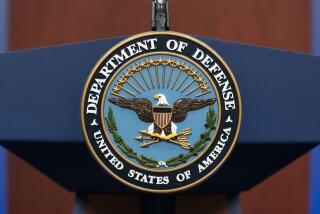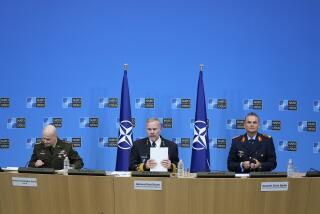Pentagon Plans Bigger Noncombat Role
- Share via
WASHINGTON — The Pentagon’s strategic blueprint for the next decade will increasingly emphasize the military’s expanding--and controversial--noncombat roles, from peacekeeping and drug interdiction to humanitarian aid, officials said Wednesday.
Although such missions have critics on Capitol Hill and in the military itself, a Pentagon draft report says the armed forces should be equipped to take on many more of the two dozen such deployments that the United States has mounted since the fall of the Berlin Wall in 1989.
Such assignments are “just reality,” said Lt. Col. Tim Muchmore, an Army staff officer who has been closely involved in the Pentagon’s study. “They’re out there for us.”
The report, due for completion in mid-May, predicts that the Cold War’s end has brought a strategic “pause” that will leave the United States an unrivaled superpower until at least 2010. Nonetheless, it calls for the armed forces to master a full range of military roles--what one official called “full-spectrum dominance.”
As in earlier studies of the military’s mission, the Pentagon report calls for the armed forces to be prepared to handle two major regional conflicts--such as those that could explode in such international hot spots as Iraq and Korea--in “close succession.”
The military has been spending an average of $3 billion a year on noncombat deployments that involve an average of 20,000 troops at a time. At the moment, U.S. troops are on peacekeeping missions in Bosnia, Macedonia, Haiti, Iraq and the Sinai.
Some top military officials have come to look more favorably in recent years on such efforts, in part because they keep defense funds flowing at a time of post-Cold War downsizing and budget shrinkage. They also view them as an effective way to pacify regions before battles become bloodier.
But critics, who include the Republican congressional leadership, complain that these deployments assign key units to repetitive, often dulling tasks when they should be training to improve their military skills.
A recent study prepared for the Army of its troops serving in Bosnia found that prolonged duty there hurt combat readiness and morale; some soldiers were so unhappy they quit the military.
Some officials familiar with the Pentagon report said that even as it calls for the military to expand its role, left unanswered so far is the core question of what functions and personnel will be sacrificed to pay for new activities.
Most predictions call for defense spending to remain flat at about $250 billion in current dollars over the next few years.
One Senate aide noted that GOP senators, as well as some Democrats, have argued that noncombat deployments should be rare because they “take away from readiness and soak up money that should be going to modernization” of the armed forces. Not long ago, the aide said, Secretary of Defense William S. Cohen was “saying exactly that” as a Maine Republican serving on the Senate Armed Services Committee.
The current study is being prepared for Cohen, who will oversee its final form and send it to Congress.
Insiders say the study will probably not result in a recommendation that the military set up and equip special units for noncombat missions.
Some advocates of these missions have argued that specially trained and equipped troops could be a less costly and more efficient way to handle such situations. But military officials believe this approach would divert troops who should be trained and prepared for the conflicts that more directly affect American security.
The report, which has been circulating in draft form for several weeks among Pentagon officials, was mandated by Congress and must be prepared every four years.
Pentagon officials said that many parts of the report have yet to be written and that portions may be changed before the so-called Quadrennial Defense Review is completed by Cohen.
Before the report is completed, heated battles are likely among defense officials on which parts of the military might be scaled back to pay for such recommendations as expansion of noncombat deployments. There has been talk of cutting two active-duty Army divisions, two Air Force wings and possibly some Navy facilities.
As details of the draft report have spread, some critics have faulted it for lacking sufficient scope. Michael Vickers, director of strategic studies at the Center for Strategic and Budgetary Assessments, a Washington think tank, termed the report a “compromise document that nobody is very happy with. They’ve spent a lot of time to end up changing only a few things at the margins.”
More to Read
Sign up for Essential California
The most important California stories and recommendations in your inbox every morning.
You may occasionally receive promotional content from the Los Angeles Times.











